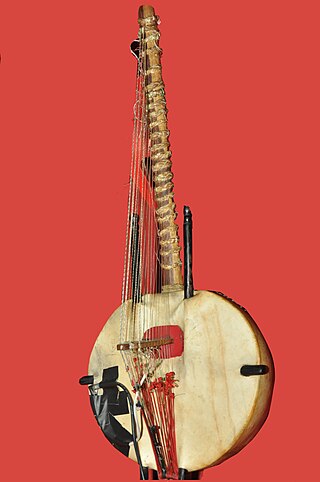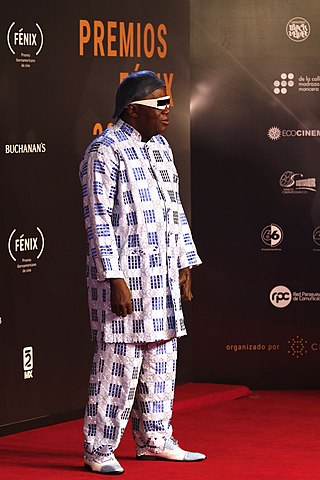
The kora is a stringed instrument used extensively in West Africa. A kora typically has 21 strings, which are played by plucking with the fingers. It has features of the lute and harp.

Senegal's music is best known abroad due to the popularity of mbalax, a development of conservative music from different ethnic groups and sabar drumming popularized internationally by Youssou N'Dour.
The Senegambia is, in the narrow sense, a historical name for a geographical region in West Africa, named after the Senegal River in the north and the Gambia River in the south. However, there are also text sources which state that Senegambia is understood in a broader sense and equated with the term the Western region. This refers to the coastal areas between Senegal and Sierra Leone, where the inland border in the east was not further defined.

A griot is a West African historian, storyteller, praise singer, poet, and/or musician.

The Mandinka or Malinke are a West African ethnic group primarily found in southern Mali, The Gambia, southern Senegal and eastern Guinea. Numbering about 11 million, they are the largest subgroup of the Mandé peoples and one of the largest ethnolinguistic groups in Africa. They speak the Manding languages in the Mande language family, which are a lingua franca in much of West Africa. Virtually all of Mandinka people are adherent to Islam, mostly based on the Maliki jurisprudence. They are predominantly subsistence farmers and live in rural villages. Their largest urban center is Bamako, the capital of Mali.

Xalam is a traditional lute from West Africa with 1 to 5 strings. The xalam is commonly played in Mali, Gambia, Senegal, Niger, Northern Nigeria, Northern Ghana, Burkina Faso, Mauritania, and Western Sahara. The xalam and its variants are known by various names in other languages, including bappe, diassare, hoddu (Pulaar), koliko (Gurunsi), kologo (Frafra), komsa, kontigi, gurmi, garaya (Hausa), koni, konting (Mandinka), molo (Songhay/Zarma), ndere, ngoni (Bambara), and tidinit.

The music of West Africa has a significant history, and its varied sounds reflect the wide range of influences from the area's regions and historical periods.

The Wolof, the largest ethnic group in Senegal, have a distinctive musical tradition that, along with the influence of neighboring Fulani, Tukulor, Serer, Jola, and Mandinka cultures, has contributed greatly to popular Senegalese music, and to West African music in general. Wolof music takes its roots from the Serer musical tradition, particularly from the Serer pre-colonial Kingdom of Saloum. Virtually all Wolof musical terminology including musical instruments comes from the Serer language.
Alhaji Bai Konte (1920–1983) was a jali from Brikama, Gambia. His grandfather, Jali Ndaba Konteh, was a Konting player who originally brought his family to Brikama from the Kankaba region of Mali. Bai Konte's father, Burama Konte, was also a celebrated kora player and composed several important pieces in the repertoire. Burama Konte, composed the anthem of the 19th century Senegambian hero Mansumaneh Yundum, Yundum N'ko. It was from that piece that the anthems of Sheriff Sidi Hydara and Nyansu Mbasse originated. Burama Konteh was a well-known kora player of his generation. Bai Konte was a regular on Radio Gambia and Radio Senegal's joint program called Chossani Senegambia in the 1970s. He and other griots such as Jali Nyama Suso and Alhaji Abdoulaye Samba used to play live music during the show. Bai Konteh had narrated many epics on that show including the epic of King Abdou Njie and his griot and advisor Ibra Faye. Prominent broadcasters of that show included Alhaji Alieu Ebrima Cham Joof, Alhaji Assan Njie and Alhaji Mansour Njie.
Mbalax is the urban dance music of Senegal, Mauritania and the Gambia. The musical style is rooted in the indigenous instrumental and vocal styles accompanied by polyrhythmic sabar drumming of the Wolof, a social identity that includes both the original Wolof people of the Greater Senegambia region and the urban panethnic identity that arose during colonialism. A cultural value proved by Wolof is their one's and respect of other cultural and musical practices. Therefore the origins of mbalax include a fusion of Wolof, Soce, and Serer music, rhythms, and instrumentation. The Wolof ability to include the diverse styles from Senegambian groups has allowed the sabar and its modern music formation to thrive. It is not uncommon, for example, for a sabar event to include music of the Serer such as the njuup, which is connected to sacred ndut rite ceremonies. In this way many ethnic groups may participate and the inclusion also increases the accessibilyt and popularity of the genre. In the 1970s, mbalax arose as Senegalese fused indigenous music styles with urban dance music from the African diaspora, the West, and the continent. These foreign sounds included U.S. soul, jazz, and salsa. Afro Cuban musics from the diaspora, Congolese rumba, and rock were also fused with the rhythms of sabar that were now played on the electric bass, guitar and keyboards.

The sabar is a traditional drum from Senegal that is also played in the Gambia. It is associated with Wolof and Serer people.

Foday Musa Suso is a Gambian musician and composer. He is a member of the Mandinka ethnic group, and is a griot. Griots are the oral historians and musicians of the Mandingo people who live in several west African nations. Griots are a living library for the community providing history, entertainment, and wisdom while playing and singing their songs. It is an extensive verbal and musical heritage that can only be passed down within a griot family.
Daniel Laemouahuma Jatta is a Jola scholar and musician from Mandinary, Gambia, who pioneered the research and documentation of the akonting, a Jola folk lute, as well as the related Manjago folk lute, the buchundu, in the mid-1980s. Prior to Jatta's work, these instruments were largely unknown outside the rural villages of the Senegambia region of West Africa.
Radiodiffusion Télévision Sénégalaise (RTS) is the Senegalese public broadcasting company.
Musa M'Boob is a Gambian musician.

The Serer people are a West African ethnoreligious group. They are the third-largest ethnic group in Senegal, making up 15% of the Senegalese population. They also reside in northern Gambia and southern Mauritania.
Dembo Konte(or Konté) and Kausu Kuyateh were master kora players from West Africa. They were also singers and, above all, jalis; storytellers and guardians of oral tradition, preserving the history of people and events via their music. Stories and history are passed down from generation to generation by this method within families and groups of friends, ensuring survival of such stories for centuries. The jali sings the praises of his friends and benefactors, warns the politicians of their errors and admonishes the listeners to live right. Their music encapsulates the Mandinka culture.
Jaliba Kuyateh is a Gambian musician. He is well known internationally as the "King of Kora." His music mixes traditional kora beats with modern pop music and is often referred to as "kora pop. " Kuyateh is a former school teacher, a resident of Brikama, and performs extensively abroad.
Super Diamono was a ten-member band from Dakar, Senegal. It was formed in 1974 or 1975. Omar Pene was a founding-member, and the group was alternately led by the singers Mamadou Lamine Maïga and Musa Ngum. It started with traditional West African music, but quickly turned to an Afro-Cuban and pop-influenced sound. From 1977 they called their music "Mbalax-blues". In 1979, Ismaël Lô, a co-founder of the group, rejoined the band as a guitar player, but soon left again for his solo career. According to Billboard Magazine, it was Senegal's "first truly local pop style." Many of the former members who later became solo artists made their break-through from this band.
Musa Ngum was a singer and songwriter who was very popular in Senegal and Gambia. He was one of the pioneers of mbalax music, and "helped to define the mbalax style of popular music in the Senegambia" and "had a strong influence on Youssou N'Dour and other mbalax pioneers". He was "something of a cult icon back in the Senegambia region, and a pioneer of the mbalax fusion style". The mbalax, which originated from the Serer religious and ultra–conservative njuup music tradition sang during Ndut rites by circumcised boys was the foundation of Ngum's music career. He mastered many of the njuup classics and built a name for himself while at the same time developing his voice.










